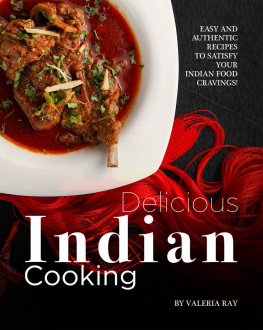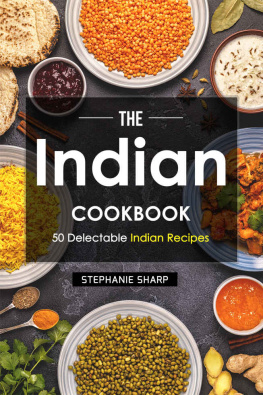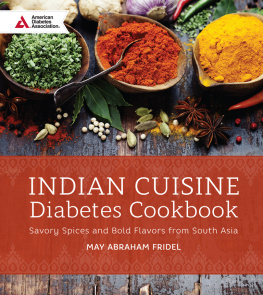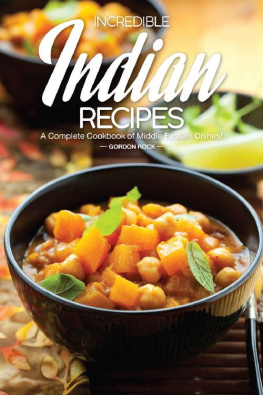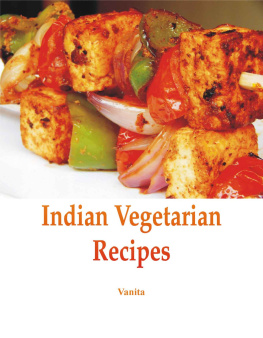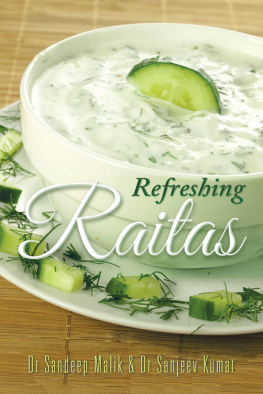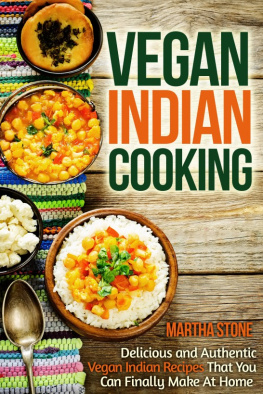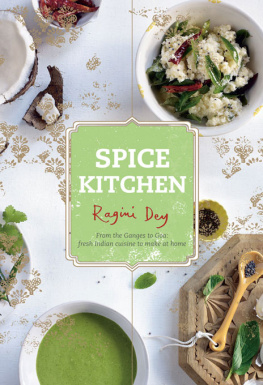INDIAN CUISINE
Dr. Jay Polmar
Copyright 2015 Dr. Jay Polmar - Cuautla, MOR, Mxico
Table of Contents
Introduction
Indian cuisine is ancient, diverse, and steeped in tradition, an amalgam of different ethnic influences, much like the country itself. The spicy food displayed at buffets in the US, or the ubiquitous curry in Britain are only a small fraction of the variety and quality available to food lovers.
Over 80% of Indians follow the Hindu religion and its offshoots such as Jainism. Hinduism prescribes respect for life forms and has contributed to the prevalence of vegetarianism in India, particularly in the North. One impact of this on cuisine is that lentils and beans are the main sources of protein as opposed to fish and meat. Although cows are sacred to Hindus, milk is considered auspicious and milk products such as curd, vegan cottage cheese ('paneer') and sweets made of milk solids are part of the cuisine. Spices are generously used to provide variety in the vegetarian diet. Certain sects of Hinduism forbid the use of onions and garlic in food, and so substitute flavorings such as cumin seeds, ginger, and cashew paste have been incorporated into the cuisine.
Climate varies across the country and as a result, different regions are characterized by distinct food habits based on what was locally available. These differences have been erased somewhat by modern transportation, but much of Indian food (especially vegetables) is grown and consumed locally. One key difference in cuisine linked to climate is the type of staple cereal consumed. Wheat dominates in the North Indian diet, whilst rice is the key cereal in South India. North India is famous for its many varieties of wheat breads. 'Rotis', 'naans', 'paranthas', and pooris are but a few of the many varieties available, distinguished by the type of wheat flour (whole or refined), method of cooking (fried, cooked on a griddle, or baked in a clay oven), shape and size (single layered, multiple layered, large or small) and whether plain or stuffed with vegetables. South India has innovated in rice preparations. Endless varieties of rice dishes have been developed based on whether rice is boiled and flavored (e.g. 'curd rice', 'rasam rice'), ground into paste with lentils and steamed or cooked on a griddle ('idlis'and 'dosas'), fermented using coconut alcohol ('appam'), or made into steamed noodles ('idiappam'). Kerala and Goa (in West India) and Bengal and Orissa (East India) are coastal states famous for seafood, although the flavoring of choice is coconut milk and souring agents (such as mango or tamarind) in the West and mustard in the East. Cooking oils vary widely mustard oil in used in Eastern India, coconut oil in Kerala, and sunfl ower oil in North India. North India has distinct seasons (summer, rainy season, and winter) bringing changes in seasonal vegetables available whilst the South is humid and warm year-round with no major changes in the types of vegetables available. Hence there is more variety of vegetarian dishes in the North. Common vegetables in the South include raw bananas, roots, and leafy greens and preparations often include fine chopping possibly to increase the flavor of these rather bland vegetables. North Indian vegetarian preparations often features whole vegetables cut large (such as whole brinjals) to take advantage of the natural flavors of these foods. In both the North and the South, fish and meat are cut into small pieces to make strongly flavored curries useful when feeding large families when meat and fish was hard to afford.
To truly understand differences in Indian cuisine, one must not only examine how individual dishes vary, but also how each dish fits into the overall food consumption pattern in that region. The traditional Indian diet across the country is extremely healthy, with cereals and vegetables forming the bulk of consumption. Meat and fish are eaten in very small quantities along with rice or wheat. Heavy use of spices served not only to ensure that the diet incorporated many spices with medicinal value such as turmeric, but also restricted consumption of vegetables, meat and fish relative to cereal by providing a feeling of fullness to the individual even when quantity was restricted.
Source: Roopa Verghese, Indian Food Gourmet, 2007
Recipes
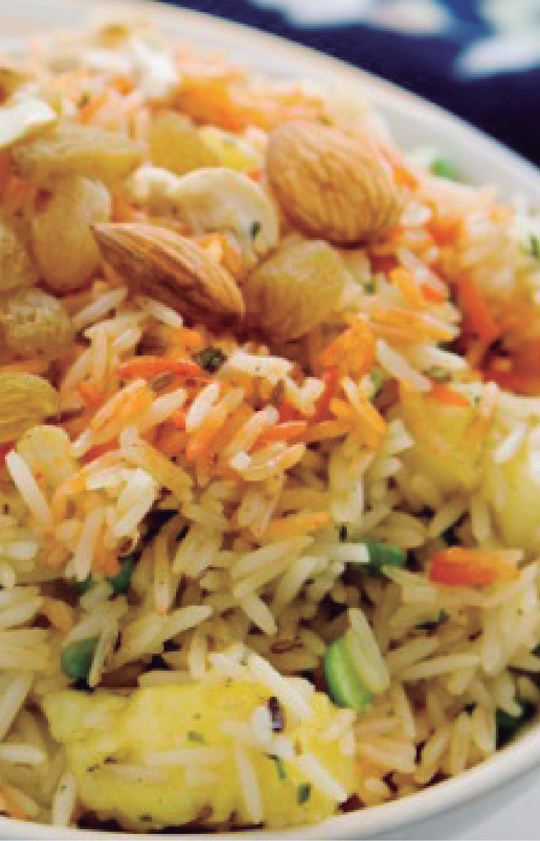
Biryani
Biryani, an evergreen classic, really needs no introduction. It's aromatic, it's heavenly and one of the most loved delicacies of the country.
Rice is widely consumed in the Southern part of the country owing to which one can find a miscellany of mouthwatering versions. South India boasts of a wide variety of Biryanis over any other part of the country. Hyderabad itself is said to cook up to 40 distinct versions.
The perfect Biryani calls for meticulously measured ingredients and practiced technique. Biryani involves cooking rice and meat separately and finally cooking them together by forming layers of each in a vessel. One of the most famous ways of cooking Biryani is the dum method. It involves sealing the vessel thoroughly and keeping the lid closed to trap in the aroma. The Biryani is then cooked over slow fire/dum.
Traditionally, Biryanis can be classified under two categories - Pakki, wherein cooked meat is coupled with half-cooked rice and further cooked - and Katchi which involves raw mutton pieces, marinated in yogurt and spices, cooked together with uncooked rice.
Choosing the perfect variety of rice is of the utmost importance. You can either go for the traditional Basmati or some of the local gems like Zeera Samba, Golden Sela, Kaima, Jeerakashala and Kala Bhaat. South India often cooks up its Biryanis using some of the local varieties of rice that render distinct taste, texture and aroma to the dish.
Your vegetables should be garden fresh and cooked separately while meat should be of the finest quality. Fish, prawns and vegetables take lesser time to cook over big chicken chunks or meat pieces. The cooking time therefore depends a lot on the ingredients used. When cooking with meat/chicken, ensure using small, soft tender portions to facilitate quicker cooking. Meat/ chicken should be marinated well before cooking with rice.
A wide range of aromatic spices come together to create a beautiful pot of Biryani. The use of spices differs from region to region. Coconut Milk, Cream, Yogurt, Buttermilk are often used in preparing some of the most sensational Biryanis while the spices include the regular affair. Kerala is famous for using Star Anise in its rice preparations. Khada Masala - ungrounded spices/whole spices - is widely used to render a distinct flavor to the preparation.
A perfect Biryani can never be bereft of the sensational aroma. A quintessential Biryani is always studded with a scented element which takes the aromatic quotient to yet another level. Jasmine, Rose, Kewra, Saffron and Screw-pine are widely used for this purpose.

Chicken Reshmi Biryani, by Chef Niru Gupta
6 SERVINGS
Ingredients
- 1 kg chicken (broiler), cut into 8 pieces
- 1 kg onions, sliced uniformly
- Oil for frying the onions
- 1 cup finely chopped hara dhania (coriander leaves)
- tsp garlic paste
- tsp ginger paste
- 1 Tbsp powdered dhania (coriander seeds)
- tsp haldi (turmeric)
- 2 tsp chilli powder
- tsp garam masala
- 1 cup (200 g) dahi (yogurt)
Next page


